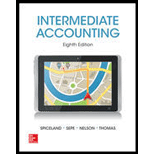
Intermediate Accounting w/ Annual Report; Connect Access Card
8th Edition
ISBN: 9781259546860
Author: J. David Spiceland
Publisher: McGraw-Hill Education
expand_more
expand_more
format_list_bulleted
Question
Chapter A, Problem A.1Q
To determine
Financial instrument: A financial instrument can be cash, or a share of ownership (stock investments), or a contractual obligation to deliver (accounts payable) or receive cash (
To explain: The reason for financial instruments being called as derivatives
Expert Solution & Answer
Explanation of Solution
Some financial instruments are meant for managing risk in the financial markets. These financial instruments exist to safeguard against the risk created by other financial instruments. Some examples of such financial instruments are forward contracts, interest rate swaps, futures, and options. These financial instruments derive the values from the future value of underlying security or index. Hence, some financial instruments are called as derivatives.
Conclusion
Since some financial instruments derive the values from the future value of underlying security or index, they are called as derivatives.
Want to see more full solutions like this?
Subscribe now to access step-by-step solutions to millions of textbook problems written by subject matter experts!
Students have asked these similar questions
Can you explain this general accounting question using accurate calculation methods?
Can you explain the correct approach to solve this general accounting question?
Please help me solve this general accounting question using the right accounting principles.
Chapter A Solutions
Intermediate Accounting w/ Annual Report; Connect Access Card
Knowledge Booster
Similar questions
- General accountingarrow_forwardCan you help me solve this general accounting question using the correct accounting procedures?arrow_forwardQuestion 5 of 11 Your answer is partially correct. 8.87/14 E ! Here are selected 2027 transactions of Riverbed Company. Jan. 1 June 30 Dec. 31 Retired a piece of machinery that was purchased on January 1, 2017. The machine cost $63,000 and had a useful life of 10 years with no salvage value. Sold a computer that was purchased on January 1, 2024. The computer cost $40,300 and had a useful life of 5 years with no salvage value. The computer was sold for $15,100 cash. Discarded a delivery truck that was purchased on January 1, 2023. The truck cost $33,780. It was depreciated based on a 6-year useful life with a $3,000 salvage value. Journalize all entries required on the above dates, including entries to update depreciation on assets disposed of where applicable. Riverbed Company uses straight-line depreciation. (Assume depreciation is up to date as of December 31, 2026.) (List all debit entries before credit entries. Credit account titles are automatically indented when amount is…arrow_forward
- I need help solving this general accounting question with the proper methodology.arrow_forwardCan you explain the correct methodology to solve this general accounting problem?arrow_forwardwork Question 6 of 11 Pronghorn Company, organized in 2025, has the following transactions related to intangible assets. 1/2/27 Purchased patent (8-year life) $592,000 4/1/27 *Goodwill (indefinite life) 375,000 7/1/27 Acquired 10-year franchise; expiration date 7/1/2037 520,000 9/1/27 Incurred research and development costs 178,000 4.74/14 E *The goodwill resulted from the purchase of a small company for cash in the amount of $750,000. At the time of acquisition, the fair value of the assets totaled $1,850,000, and the fair value of the liabilities totaled $1,475,000. (a1) Your answer is partially correct. Prepare the necessary entries to record these intangibles. All costs incurred were for cash. Make the adjusting entries as of December 31, 2027, recording any necessary amortization and reflecting all balances accurately as of that date. (List all debit entries before credit entries. Credit account titles are automatically indented when amount is entered. Do not indent manually.…arrow_forward
arrow_back_ios
SEE MORE QUESTIONS
arrow_forward_ios
Recommended textbooks for you

 AccountingAccountingISBN:9781337272094Author:WARREN, Carl S., Reeve, James M., Duchac, Jonathan E.Publisher:Cengage Learning,
AccountingAccountingISBN:9781337272094Author:WARREN, Carl S., Reeve, James M., Duchac, Jonathan E.Publisher:Cengage Learning, Accounting Information SystemsAccountingISBN:9781337619202Author:Hall, James A.Publisher:Cengage Learning,
Accounting Information SystemsAccountingISBN:9781337619202Author:Hall, James A.Publisher:Cengage Learning, Horngren's Cost Accounting: A Managerial Emphasis...AccountingISBN:9780134475585Author:Srikant M. Datar, Madhav V. RajanPublisher:PEARSON
Horngren's Cost Accounting: A Managerial Emphasis...AccountingISBN:9780134475585Author:Srikant M. Datar, Madhav V. RajanPublisher:PEARSON Intermediate AccountingAccountingISBN:9781259722660Author:J. David Spiceland, Mark W. Nelson, Wayne M ThomasPublisher:McGraw-Hill Education
Intermediate AccountingAccountingISBN:9781259722660Author:J. David Spiceland, Mark W. Nelson, Wayne M ThomasPublisher:McGraw-Hill Education Financial and Managerial AccountingAccountingISBN:9781259726705Author:John J Wild, Ken W. Shaw, Barbara Chiappetta Fundamental Accounting PrinciplesPublisher:McGraw-Hill Education
Financial and Managerial AccountingAccountingISBN:9781259726705Author:John J Wild, Ken W. Shaw, Barbara Chiappetta Fundamental Accounting PrinciplesPublisher:McGraw-Hill Education


Accounting
Accounting
ISBN:9781337272094
Author:WARREN, Carl S., Reeve, James M., Duchac, Jonathan E.
Publisher:Cengage Learning,

Accounting Information Systems
Accounting
ISBN:9781337619202
Author:Hall, James A.
Publisher:Cengage Learning,

Horngren's Cost Accounting: A Managerial Emphasis...
Accounting
ISBN:9780134475585
Author:Srikant M. Datar, Madhav V. Rajan
Publisher:PEARSON

Intermediate Accounting
Accounting
ISBN:9781259722660
Author:J. David Spiceland, Mark W. Nelson, Wayne M Thomas
Publisher:McGraw-Hill Education

Financial and Managerial Accounting
Accounting
ISBN:9781259726705
Author:John J Wild, Ken W. Shaw, Barbara Chiappetta Fundamental Accounting Principles
Publisher:McGraw-Hill Education